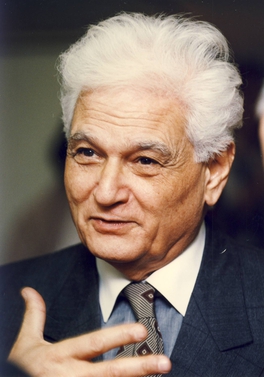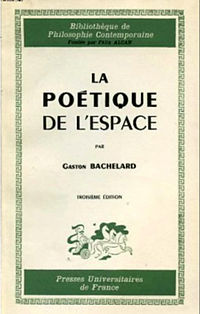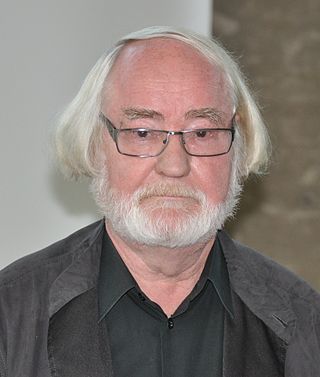
Edmund Gustav Albrecht Husserl was an Austrian-German philosopher and mathematician who established the school of phenomenology.

Maurice Jean Jacques Merleau-Ponty was a French phenomenological philosopher, strongly influenced by Edmund Husserl and Martin Heidegger. The constitution of meaning in human experience was his main interest and he wrote on perception, art, politics, religion, biology, psychology, psychoanalysis, language, nature, and history. He was the lead editor of Les Temps modernes, the leftist magazine he established with Jean-Paul Sartre and Simone de Beauvoir in 1945.

Jacques Derrida was a French philosopher. He developed the philosophy of deconstruction, which he utilized in a number of his texts, and which was developed through close readings of the linguistics of Ferdinand de Saussure and Husserlian and Heideggerian phenomenology. He is one of the major figures associated with post-structuralism and postmodern philosophy although he distanced himself from post-structuralism and disowned the word "postmodernity".

Hermeneutics is the theory and methodology of interpretation, especially the interpretation of biblical texts, wisdom literature, and philosophical texts. As necessary, hermeneutics may include the art of understanding and communication.

Phenomenology is the philosophical study of objectivity and reality as subjectively lived and experienced. It seeks to investigate the universal features of consciousness while avoiding assumptions about the external world, aiming to describe phenomena as they appear to the subject, and to explore the meaning and significance of the lived experiences.
Existential phenomenology encompasses a wide range of thinkers who take up the view that philosophy must begin from experience like phenomenology, but argues for the temporality of personal existence as the framework for analysis of the human condition.

The Poetics of Space is a 1958 book about architecture by the French philosopher Gaston Bachelard. The book is considered an important work about art. Commentators have compared Bachelard's views to those of the philosopher Martin Heidegger.

Phenomenology of Perception is a 1945 book about perception by the French philosopher Maurice Merleau-Ponty, in which the author expounds his thesis of "the primacy of perception". The work established Merleau-Ponty as the pre-eminent philosopher of the body, and is considered a major statement of French existentialism.
Dalibor Vesely was a Czech-born architectural historian and theorist who was influential through his teaching and writing in promoting the role of hermeneutics and phenomenology as part of the discourse of architecture and of architectural design.

Juhani Uolevi Pallasmaa is a Finnish architect and former professor of architecture and dean at the Helsinki University of Technology. Among the many academic and civic positions he has held are those of Director of the Museum of Finnish Architecture 1978–1983, and head of the Institute of Industrial Arts, Helsinki. He established his own architect's office – Arkkitehtitoimisto Juhani Pallasmaa KY – in 1983 in Helsinki. From 2001 to 2003, he was Raymond E. Maritz Visiting Professor of Architecture at Washington University in St. Louis, and in 2013 he received an honorary doctorate from that university. In 2010–2011, Pallasmaa served as Plym Distinguished Professor at the University of Illinois Urbana-Champaign, and in 2012-2013 he was scholar in residence at Frank Lloyd Wright's Taliesin. Pallasmaa has also lectured widely in Europe, North and South America, Africa and Asia.

"The Origin of the Work of Art" is an essay by the German philosopher Martin Heidegger. Heidegger drafted the text between 1935 and 1937, reworking it for publication in 1950 and again in 1960. Heidegger based his essay on a series of lectures he had previously delivered in Zurich and Frankfurt during the 1930s, first on the essence of the work of art and then on the question of the meaning of a "thing", marking the philosopher's first lectures on the notion of art.
Christian Norberg-Schulz was a Norwegian architect, author, educator and architectural theorist. Norberg-Schulz was part of the Modernist Movement in architecture and associated with architectural phenomenology.
Phenomenology or phenomenological psychology, a sub-discipline of psychology, is the scientific study of subjective experiences. It is an approach to psychological subject matter that attempts to explain experiences from the point of view of the subject via the analysis of their written or spoken words. The approach has its roots in the phenomenological philosophical work of Edmund Husserl.

Dan Zahavi is a Danish philosopher. He is currently a professor of philosophy at University of Copenhagen.
Nader El-Bizri is the Dean of the College of Arts, Humanities, and Social Sciences at the University of Sharjah. He served before as a tenured longstanding full Professor of philosophy and civilization studies at the American University of Beirut, where he also acted as an Associate Dean of the Faculty of Arts and Sciences, and as the Director of the General Education program. El-Bizri specializes in phenomenology, Islamic science and philosophy, and architectural theory. He is the author or editor of several books, including The Phenomenological Quest between Avicenna and Heidegger (2000).
Dermot Moran is an Irish philosopher specialising in phenomenology and in medieval philosophy, and he is also active in the dialogue between analytic and continental philosophy. He is currently the inaugural holder of the Joseph Chair in Catholic Philosophy at Boston College. He is a member of the Royal Irish Academy and a founding editor of the International Journal of Philosophical Studies.
Phenomenological description is a method of phenomenology that attempts to depict the structure of first person lived experience, rather than theoretically explain it. This method was first conceived of by Edmund Husserl. It was developed through the latter work of Martin Heidegger, Jean-Paul Sartre, Emmanuel Levinas and Maurice Merleau-Ponty — and others. It has also been developed with recent strands of modern psychology and cognitive science.

Edward S. Casey is an American philosopher and university professor. He has published several volumes on phenomenology, philosophical psychology, and the philosophy of space and place. His work is widely cited in contemporary continental philosophy. He is currently distinguished professor emeritus of philosophy at Stony Brook University in New York and distinguished visiting faculty at Pacifica Graduate Institute.
David Carr is an American phenomenology scholar and a Charles Howard Candler Professor Emeritus of Philosophy from Emory University.
David Seamon is an American geographer, phenomenologist, author and academic. Seamon in known for his work on the theory of architectural phenomenology, environmental phenomenology, and environmental design as placemaking. He is the editor of the Environmental and Architectural Phenomenology journal, published since 1990. Seamon is the author of several books in behavioral geography and place phenomenology including Life Takes Place: Phenomenology, Lifeworlds and Place Making and A Geography of the Lifeworld: Movement, Rest and Encounter. Seamon has been Professor of Environment-Behavior and Place Studies at Kansas State University since 1993.









